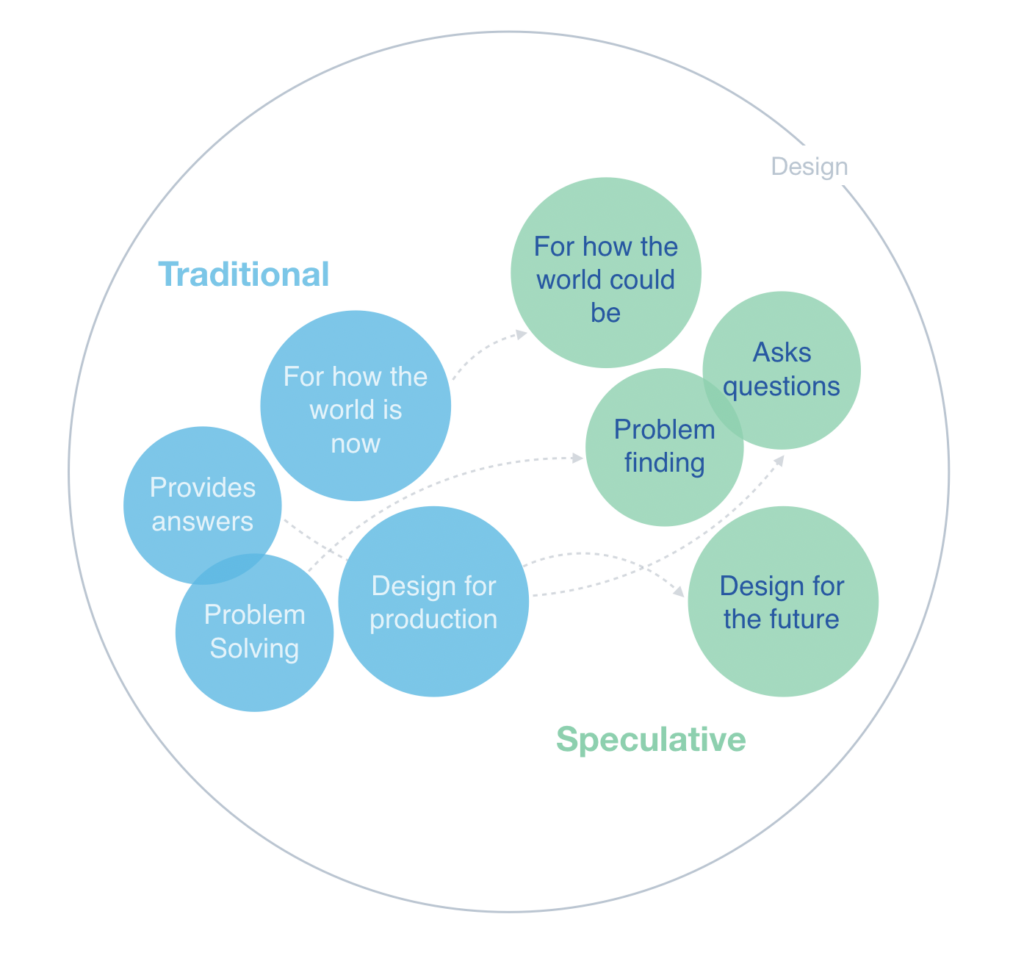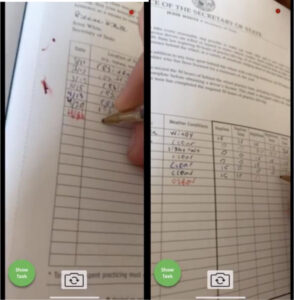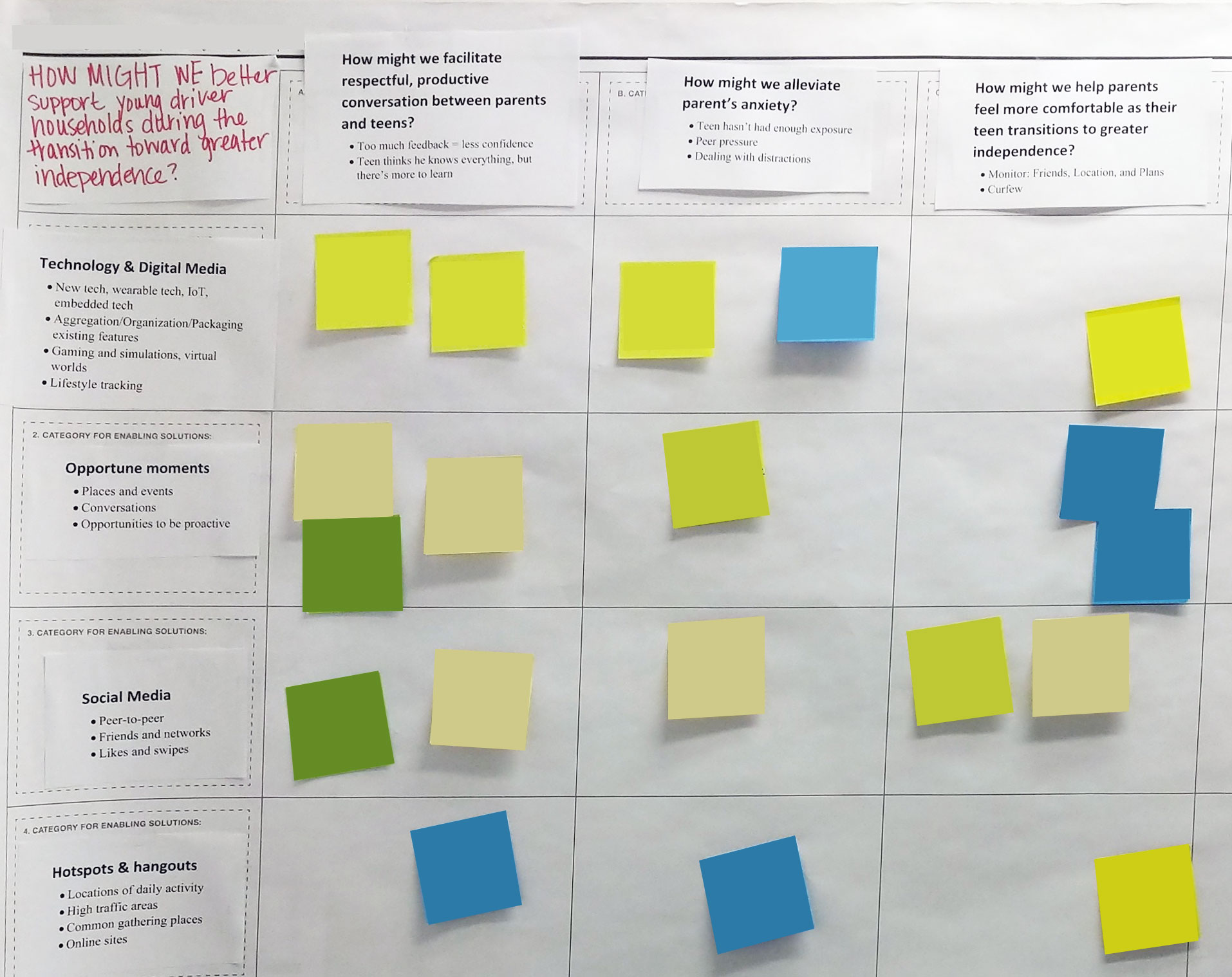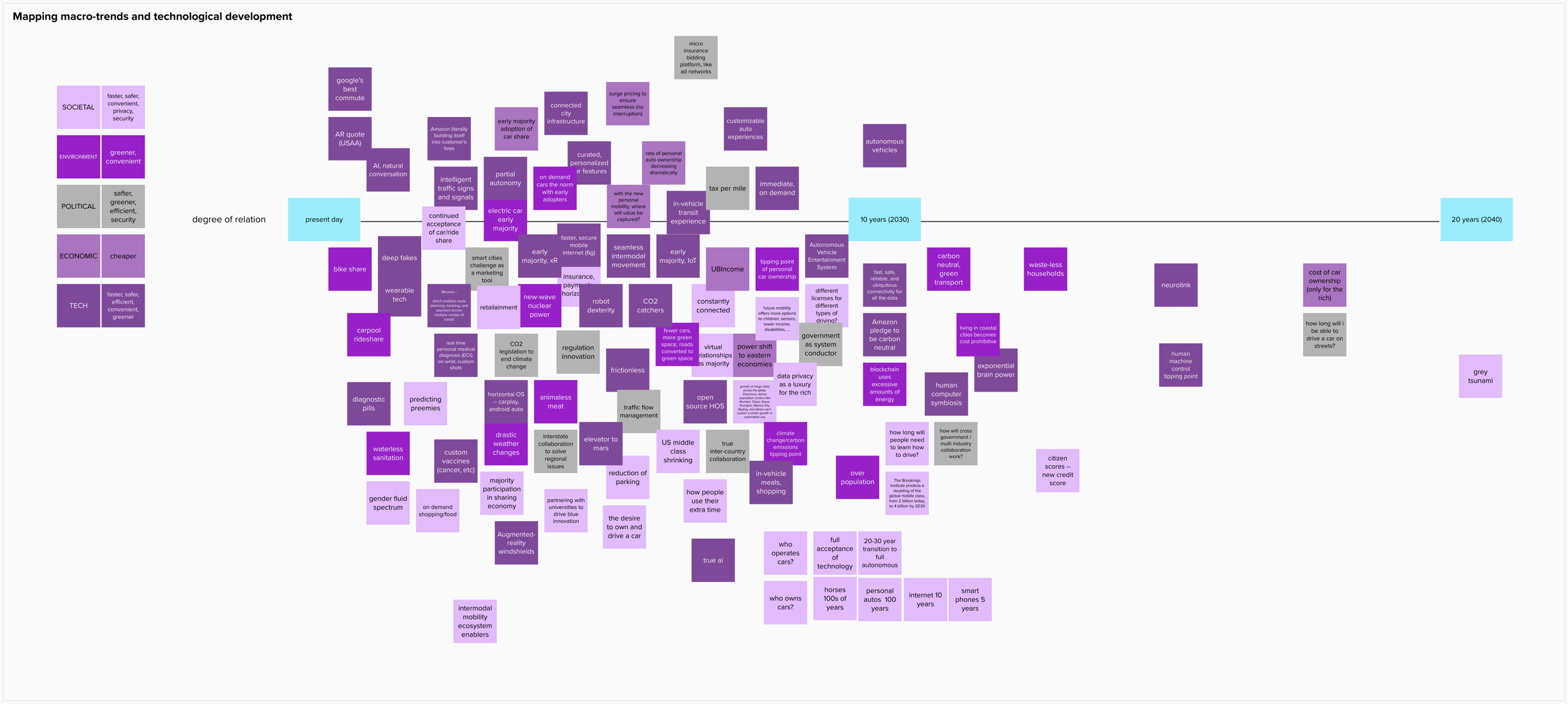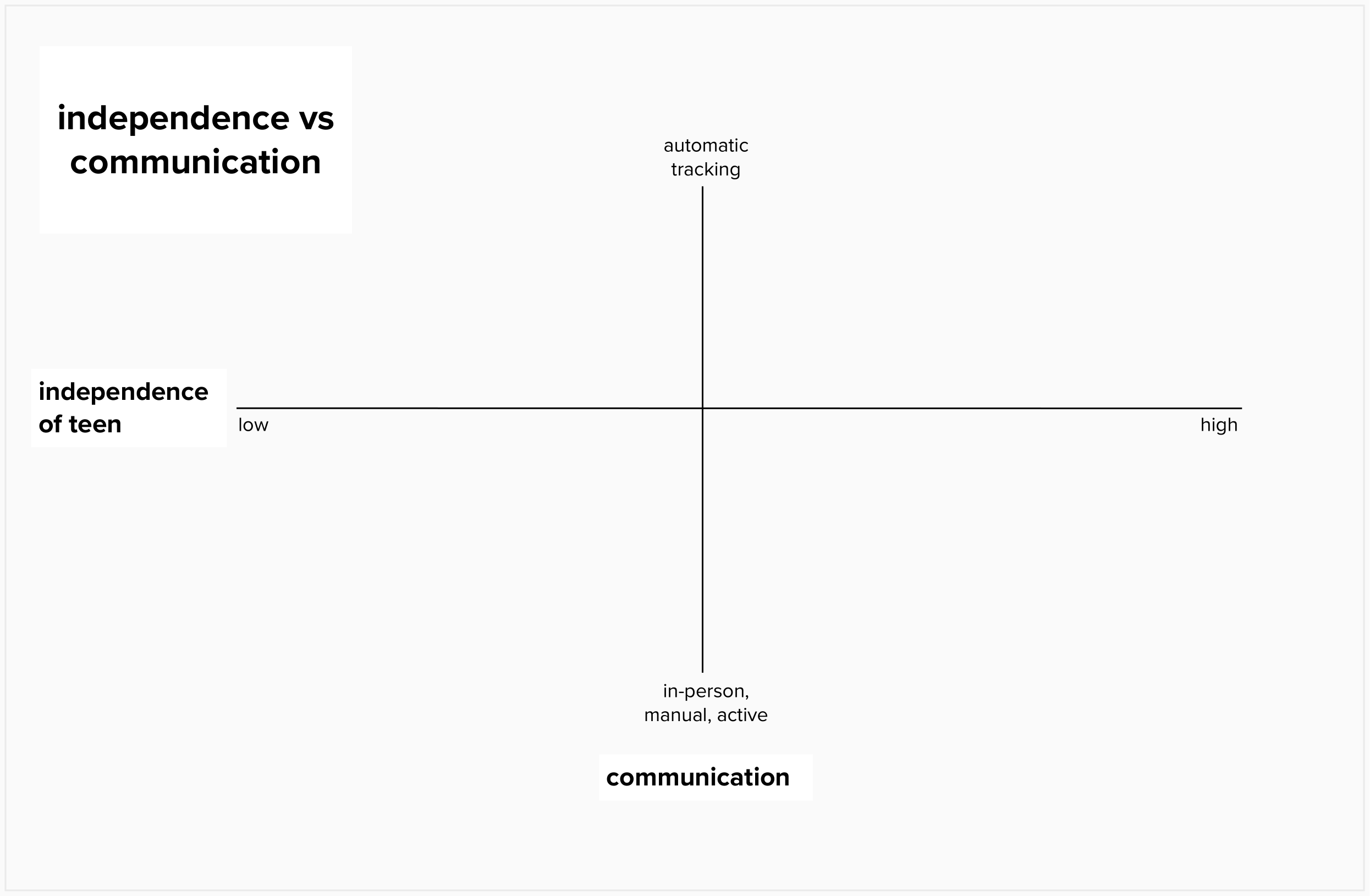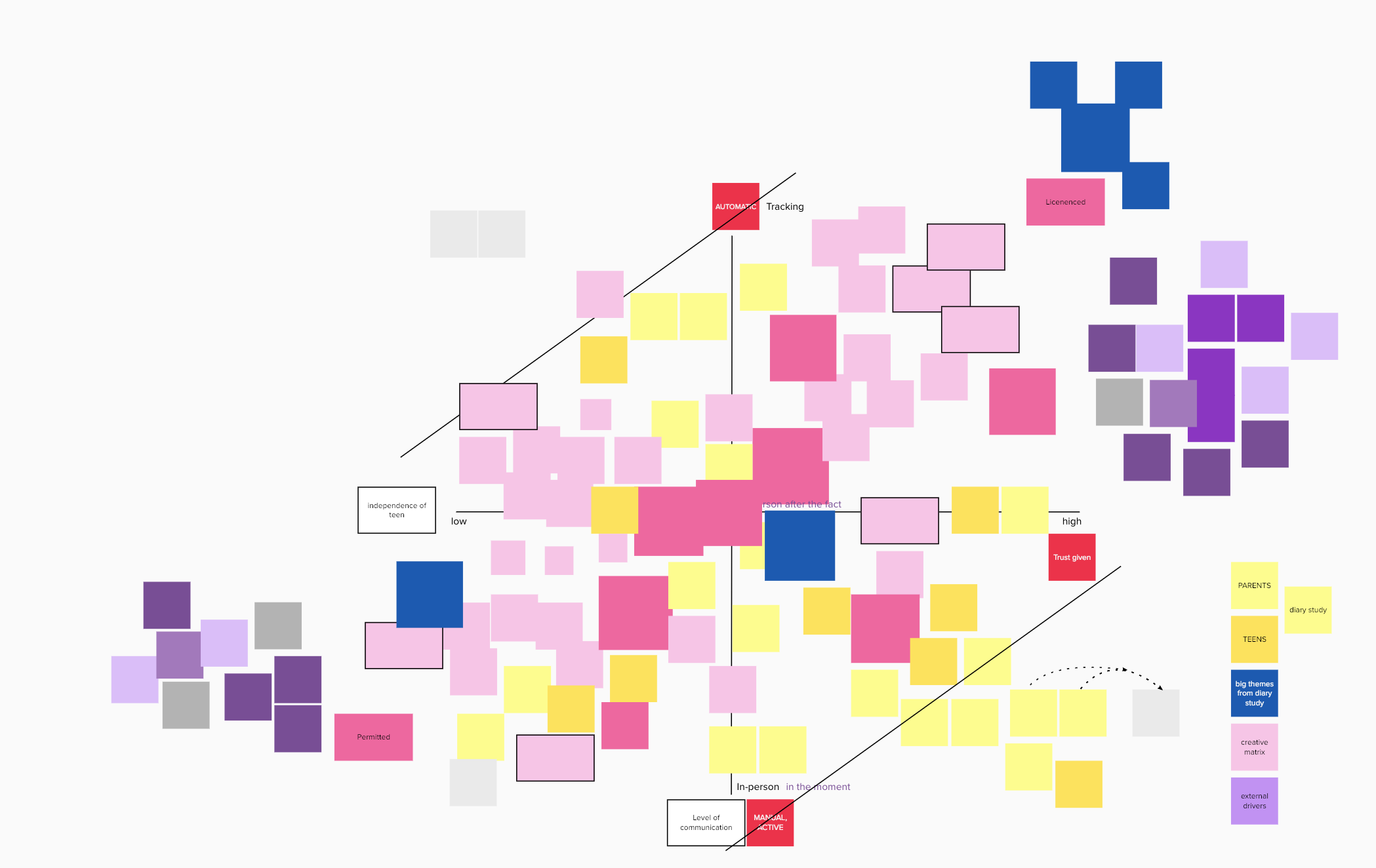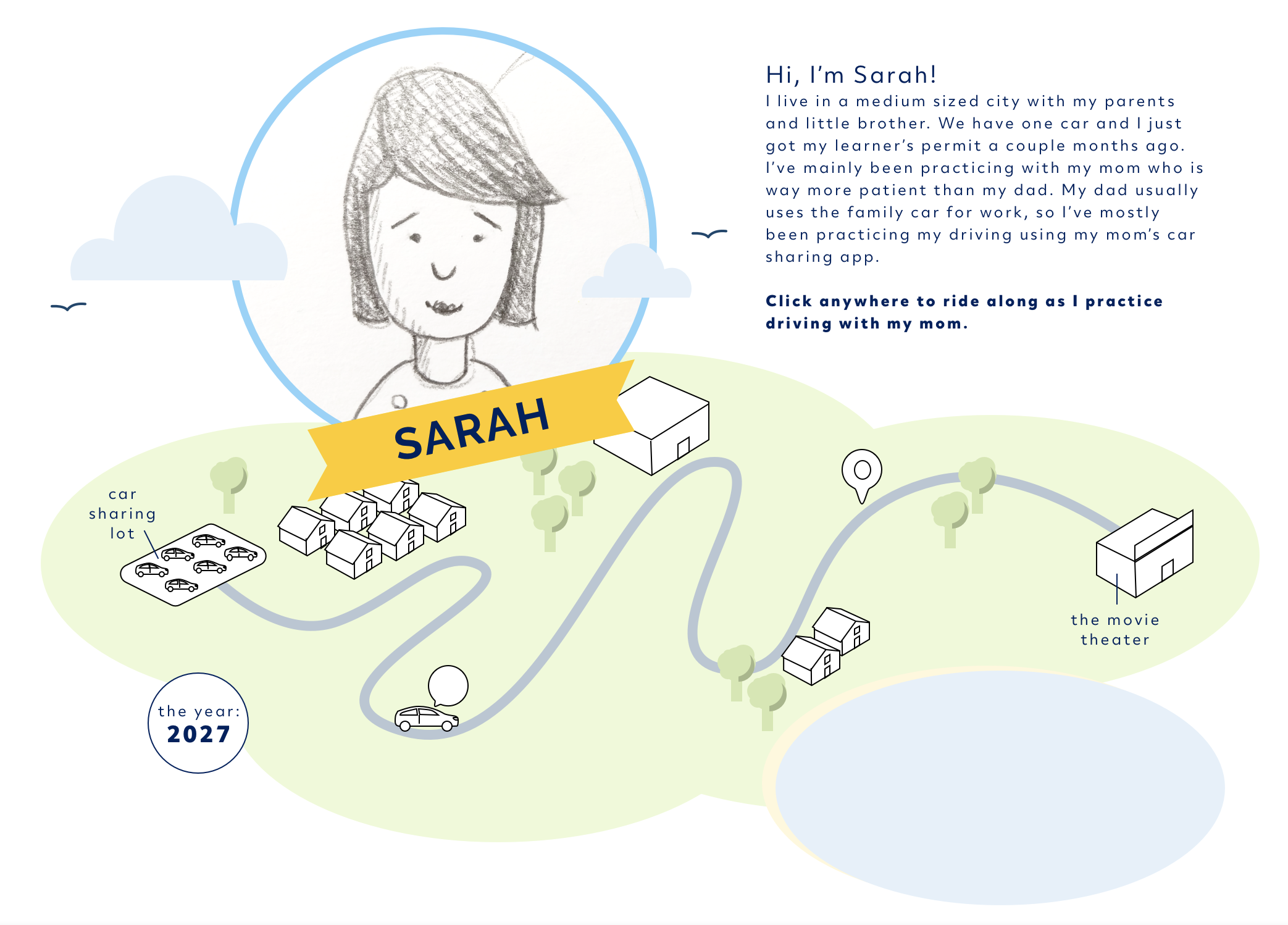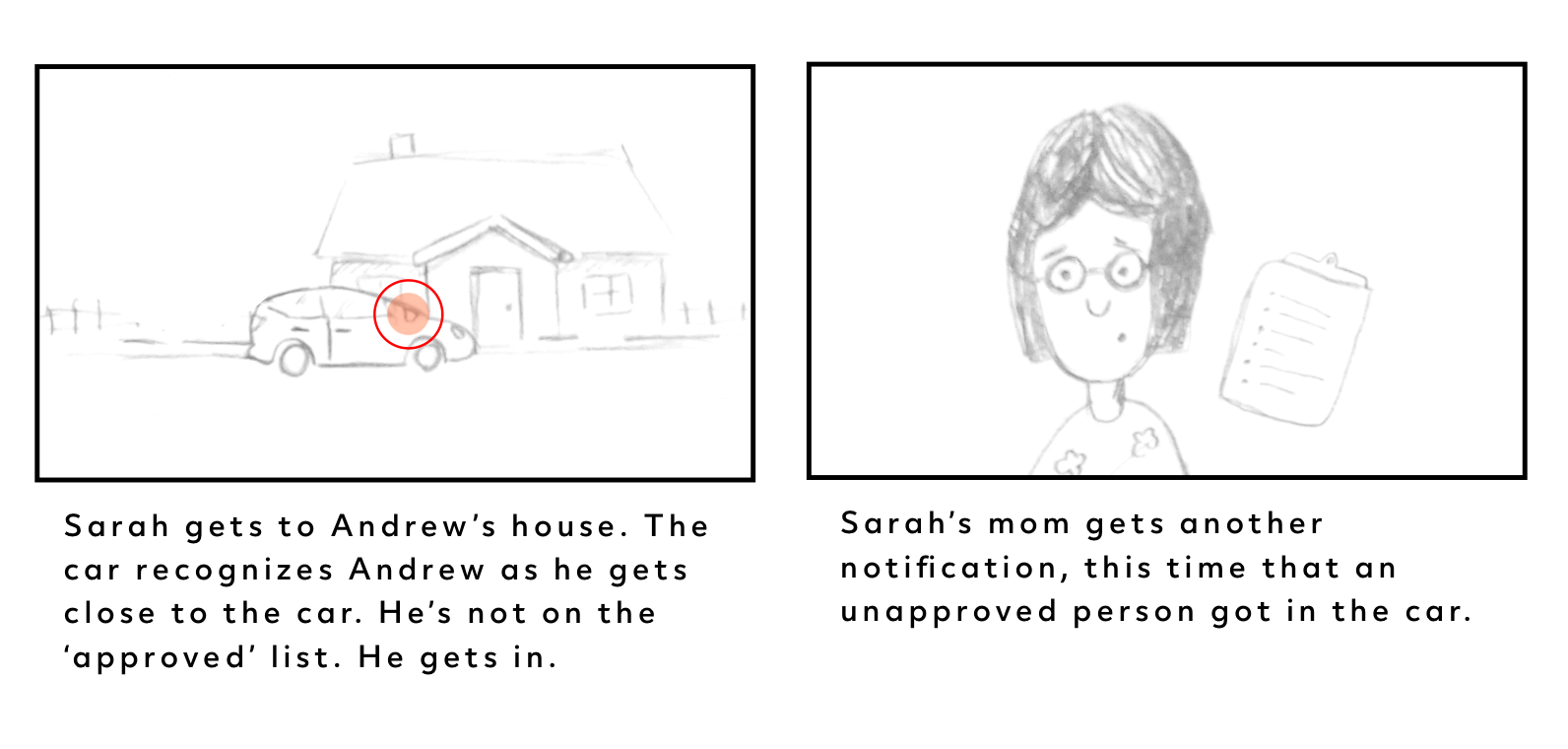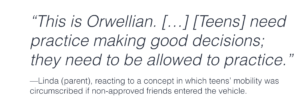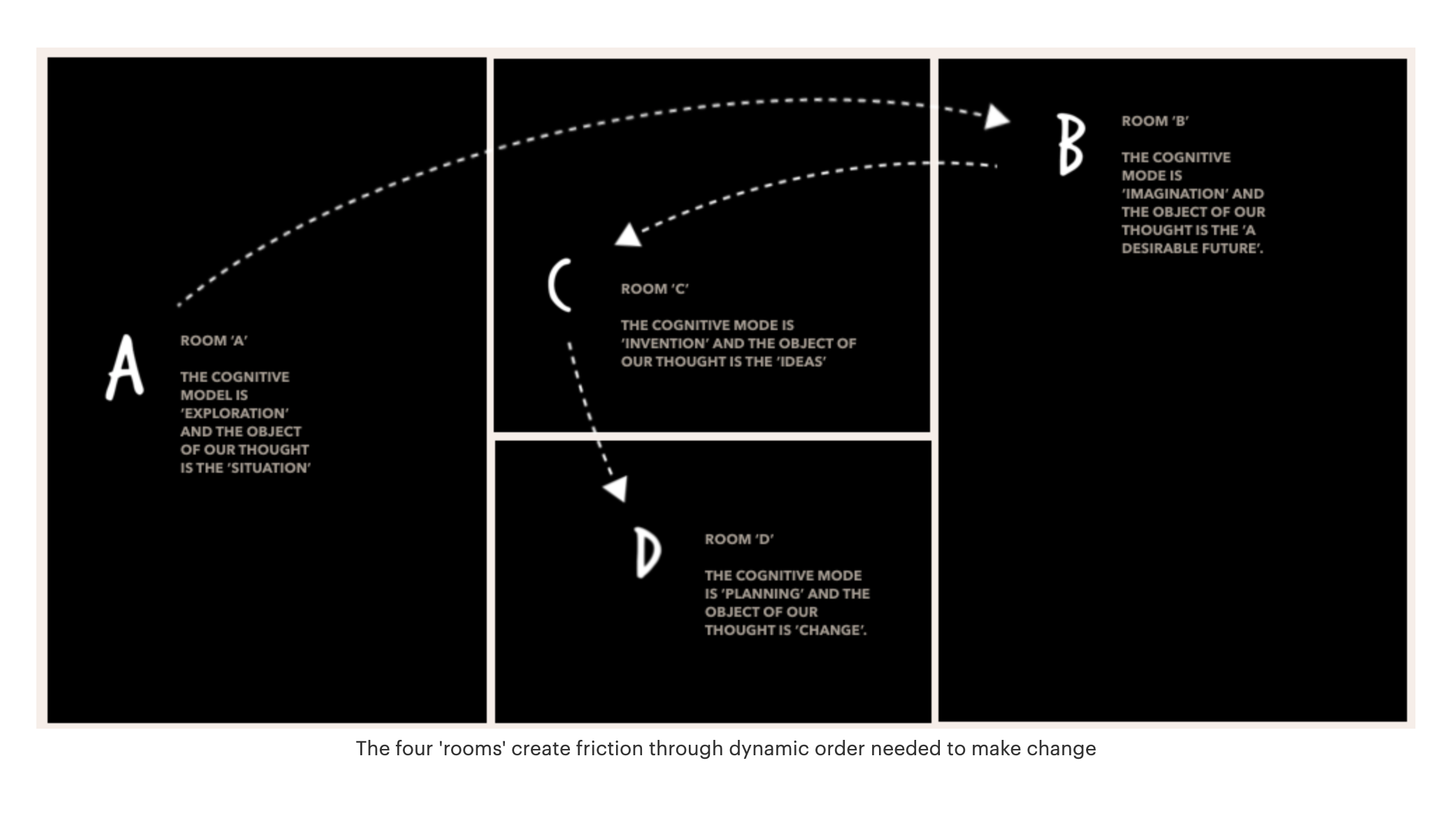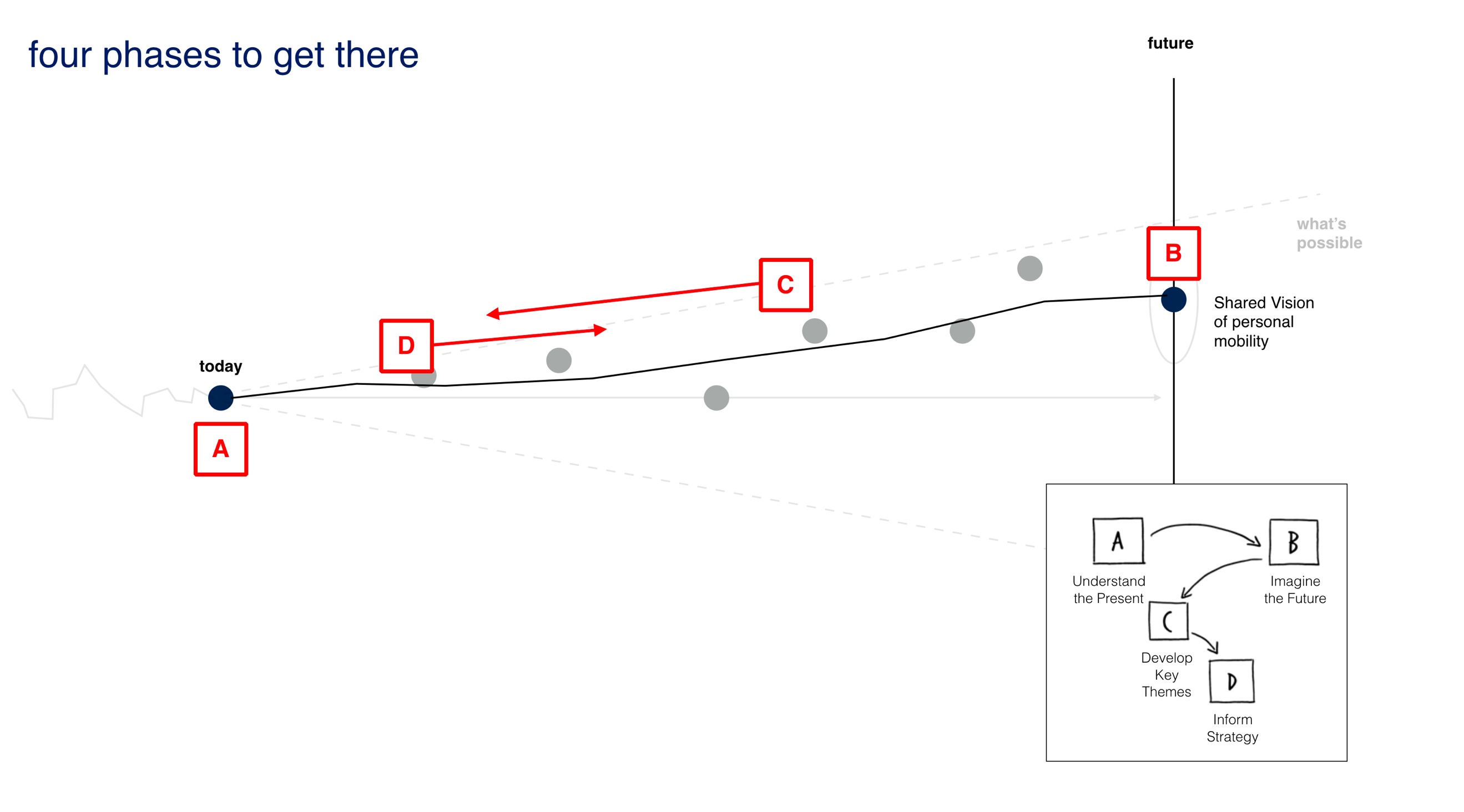The auto insurance industry is being disrupted by insurtechs that are leveraging data and technology to solve pain points in parts of the customer journey, while emerging technology in adjacent industries threatens insurance as it currently exists. As a result, insurance companies are imagining futures beyond traditional insurance and new ways that they might meet the needs of future customers. In order to explore what a reframing of insurance as “protection” could mean to customers, we utilized ethnographic methods and speculative design practices to reimagine how the transition from non-driver to young driver and from dependent child to independent adult could be more fully supported by an insurance company. In this case study, we review both the methodological processes and summarize learnings and opportunities critical to applying ethnofutures and speculative design practices within a large corporate setting, including: proposing a new approach to a diverse group of stakeholders; negotiating near- and long-term priorities; articulating the linkages between current and future states; and developing rich stimuli to create an immersive future in the context of time and resource constraints.
INDUSTRY CONTEXT AND INTRODUCTION
Through discovering and anticipating customer needs and pain points, insurance startups, or insurtechs, have been disrupting the industry by leveraging data and technology. The startups that grew up during the beginning of this digital era have a fundamental competitive advantage over much larger, legacy companies that came into fruition in the early to late 20th century. By quickly adapting to consumers and markets through new methods and technologies, these young companies have disrupted industries across the board, including insurance. They are able to move faster than their resource-rich predecessors, employing lean start-up and agile methodologies, evaluating the customer on the front- as well as the backend, and creating truly differentiated experiences that evolve and respond over time.
Perhaps modeled after Google, Amazon, Facebook, and Apple’s expansion into all aspects of life, perhaps based on the realization that the status quo is no longer enough to provide sustainable growth, historic companies have been expanding into adjacent spaces in their respective industries. As companies in adjacent industries start to overlap, it provides both opportunity, and additional competition, which, in the insurance industry threatens the existence of insurance as it exists today. As a result, insurance companies are imagining futures beyond traditional insurance and new ways that they might meet the needs of future customers by envisioning scenarios that extend their value beyond current offerings. For Allstate, part of this process is reframing itself as a data and protection company (Morgan 2019) and figuring out how to leverage the data and capabilities it has to deliver a differentiated experience.
Change isn’t new to Allstate. Started as a line of tires for Sears, Roebuck and Company, the iconic brand has evolved over the years. Originally, the first direct to consumer insurance policy, modeled after its parent company’s mail order model, Allstate once included a line of cars and scooters, has been a leader in telematics for over 10 years, and most recently piloted a new car sharing startup (Drift), acquired a data privacy company (InfoArmor), and purchased a personal device warranty company (SquareTrade). One could argue that Allstate has been ahead of the curve on playing in adjacent spaces to its core business of insurance, but only recently has it looked to broaden the scope of insurance itself to that of holistic protection with a greater focus on customer-centricity.
Over the past several years Allstate has built up internal capabilities around being customer focused including starting to adopt human-centered design practices and building customer and user experience groups. But with 80 years of history comes expected constraints with regard to both culture and agility. To use a common analogy, Allstate is the large aircraft carrier to the jet ski of an insurtech—large and steady but doesn’t change course quickly.
Culturally, Allstate is relatively conservative, not unlike many large corporations. There are a lot of different departments, often with different goals, which means cross-company initiatives can be difficult. Technology has also been a constraint. Like most large, decades-old companies, Allstate has gone through several major transitions as new technology has been introduced, but also depends on legacy systems. Although some areas of the organization have embraced agile, test and learn practices, the adoption of these new consumer-centric ways of working hasn’t been universal. In addition, regulatory departments tend to take a more conservative stance when addressing large financial services institutions due to their size and market impact.
BUSINESS CHALLENGE AND PROJECT CONTEXT
As Allstate expanded its position to become both a data and protection company (Morgan 2019), leaders sought to better understand how to fully support customers both within the insurance journey and in their broader lives. This evolution to a data-enabled “protection” company seemed to create a new wave of questions about how to leverage data to solve for customers’ latent and unmet needs in this broader context: What do our customers need? How can we provide them greater value? Where is it expected or appropriate to support in their lives?
From the previous ways of working, where solutions were sometimes developed before understanding consumer needs, these new questions felt like a revelation. In the current case study, our business partners had both long-term strategic and near-term tactical objectives; they sought to bring together disparate young driver initiatives across the organization (including product coverages and discounts, corporate relations programs, telematics solutions, and digital experiences) and articulate a strategy to more holistically support young drivers and their parents in the transition from non-driver to young driver. Using data to create additional value—beyond coverage—during the young driver life stage in the insurance experience was a way to achieve typical business objectives—grow the customer base, retain them, and appropriately assess risk—while transforming the brand.
In order to achieve both strategic, future-oriented objectives, we proposed ethnographic methods and speculative design practices to reimagine how the transition from non-driver to young driver and from dependent child to independent adult could be fully supported by a protection and data company. While parents may seek to circumscribe teens’ independence, for instance through tracking and surveillance features embedded in cars or smartphones, the company sought to support both parents’ and teens’ goals and needs as teens transition toward becoming a young driver with greater independence. Immersive and extreme futures were created to prompt teens to consider how omni-present, automatic communication through human computer symbiosis could affect their sense of self, relationship to family, notions of risk, and aspirations of freedom. By asking parents and teens to explore futures at the extremes, it was possible to identify preferable futures for both teens and parents, orient near- and mid-term action, and inform a strategy to support personal mobility experiences during this life stage.
The project was supported by a design researcher and conceptual designer (the authors of this case study). Specifically, we remined existing market and user research, completed a mobile diary study with parents and teens, and two rounds of speculative design concepting and consumer feedback to explore both non-insurance concepts that could holistically support a young driver experience and concepts within the insurance product space. In total, 18 teens and 20 parents participated in the study. Following data collection and analysis, the cross-functional team articulated a “north star”—a vision of a future young driver experience—as well as near and medium-term steps toward that vision. The overall objective was to articulate a young driver strategy that connected with parents’ and teens’ goals and needs and articulated and aligned near- and medium-term actions with the longer-term vision (Figure 1).
Figure 1. High-level overview of project.
The project brought together new stakeholders from various parts of the organization, including multiple product groups, consumer marketing, product positioning, and telematics—many of whom had not collaborated with user experience or each other. Gaining alignment about strategic work proved to be difficult, as stakeholders from different groups had different goals and priorities. While some stakeholders were focused on a longer-term strategy, other members of the cross-functional team were tasked with near-term action. They sought to understand, what do we do with the existing products and features that we have and what features provide value to customers? Thus, some stakeholders were anxious about going through a process to design the farther future when they really wanted to know what they could execute in the next couple months. As a result, we needed to negotiate multiple goals and were constrained by relatively short timelines.
MAPPING THE PROCESS
As we considered methods and a process that would create both the far and near terms within our short timelines, speculative design (and subsequently its counterpart ethnofutures) immediately came to mind. This was due to a couple of factors. One of the key distinctions of speculative design as compared to traditional design is the goal of designing for how the world could be and asking questions to determine opportunity areas (Figure 2).
Figure 2. Diagram to explain the difference between traditional design and speculative or future design (adapted from Dunne and Raby 2013).
Our business partners were interested in creating a vision that holistically supported the teen driver experience. They wanted to define an ideal future state that would be a true differentiator, if Allstate chose to pursue those opportunities. The speculative design concepts allowed both the business partners and consumer participants to explore what it would mean for an insurance company to more broadly support this major life change beyond providing an insurance product, including utilizing telematics. The teen/parent relationship is emotional in general and can be especially so with regard to learning how to drive. By focusing on these emotional moments, we were able to get rich feedback that provided a comprehensive understanding of where and where not to play a role in this transition.
To kick off the project, we worked with the market research team to mine existing marketing and user experience research that had already been done. The previous market research provided attitudinal data from both parents and teens. However, much of it was 10 to 15 years old, and was more focused on parents’ attitudes and experiences over teens’ feelings and experiences. We also conducted stakeholder interviews and examined previous initiatives and solutions to support parents of teens during this life stage, attempting to understand why previous solutions had failed and how current features are utilized by customers. In particular, unsuccessful digital solutions to support this life stage were designed for parents of teens without consideration of teens’ experiences, or were designed for teens with little consideration of the parents’—the paying customer—needs. We hypothesized that successful solutions and strategies needed to accommodate both parents’ and teens’ goals and needs, as well as articulate with both parents’ and teens’ emotions, especially given macrotrends in the teen experience, including driving at a later age, greater anxiety, greater parent involvement in teens’ lives, and greater dependence on mobile technology.
In order to gather additional data on the experience of having (parent) or being (teen) a young driver, we launched a mobile diary study among teens and their parents. This provided in-the-moment (or close to in-the-moment) qualitative feedback on experiences related to learning to drive, including completing practice drives (Figure 3), receiving/giving driving feedback, driving with friends, negotiating greater independence, experiences when a parent has said no to a request to be out of the house with friends, among other topics. The diary study lasted 10 weeks and consisted of a “check-in” every two weeks for a total of five prompts/touchpoints with participants. Five permitted teen drivers and one of each teens’ parents, and five licensed teen drivers and one of each teens’ parents were recruited. Check-ins were written to be appropriate for the participant’s role and/or place in the process and allowed the same events to be understood from a teen’s perspective and from their parent’s perspective. This research approach provided rich insight into the emotions of teens and parents, helped us to build empathy with the people going through this life stage, and drove ideation with stakeholders that was rooted in human goals and needs (to be discussed).
Figure 3. Screenshots of a permitted teen participant filling out his driving log after a practice drive with his parent during a mobile diary study check-in.
After initial analysis of the mobile diary study, a workshop was held with the cross-functional group of stakeholders to include them in the process of data analysis, build alignment throughout the process, and incorporate their feedback and ideas into future concepts. We created video collections around salient themes that emerged from the data and asked stakeholders to jot down notes and discuss them—emotions, new learnings, pain points or other details that struck them. Then we structured an ideation around the parent and teen needs (Figure 4). The ideas generated in these sessions carry over as one layer in the futuring process. For example, just as we extrapolate current technology into the future, we take near-term ideas from stakeholders and imagine how they can be pulled into the future as well.
Figure 4. During a workshop, stakeholders watched video compilations from the mobile diary study in order to empathize with parents and teens. Next, parent and teen needs were used as inputs into a structured ideation. Content (ideas) from the sticky notes have been removed. Photo credit: Ben Kuester, used with permission.
In addition to emotional and behavioral insights from the mobile diary study and ideation sessions with internal stakeholders, the creation of future concepts depended on “signals of change” (Lueck Avery et al. 2019) identified in a mining of secondary research on macro-trends, shifting values, and emerging behaviors. One of the core tenants of speculative design is making sure future concepts and stimuli fit within the realm of the possible. This was accomplished by extrapolating what currently exists in the present-day using macrotrends and “signals of change” to project what is possible in the future. This is an important consideration because the future concepts shouldn’t contain fantasy. However, the intention is to push concepts beyond just what is probable. In fact, doing only what is probable is the consequence of a culture driven by near-term release dates, and it takes away any need for having a vision or strategy.
The future has infinite possibilities and it is through decision points that a desired outcome is achieved. Secondary macrotrend research was leveraged to identify a broad range of relevant categories including, but not limited to: technology, politics, society, environment, and economics. For example, we considered how technology and economics might influence driving in the future including envisioning augmented reality and safety elements of autonomous cars, the sharing economy, and a decrease in car ownership, and incorporated these into concepts (Figure 5).
Figure 5. Macrotrends from five broad categories including: societal, environmental, political, economic, and technology, collected through secondary research and organized around potential year of impact.
In creating futures we sought to explore diverse scenarios that tackle reoccurring themes we heard from the initial mobile diary study. In order to do this, we organized the various inputs for future concept development using different themes as axes of matrices to assess how inputs fit together. Each axis is evaluated at the extremes to ensure all perspectives are considered. Each quadrant of the four-square represents one of four possible scenarios within the space of the two themes being evaluated.
Two big themes that emerged during the diary study were teen independence during the transition from permitted to licensed teen and communication between teens and parents. We evaluated the former from low independence to high and the latter from in-person, in the moment communication to fully automated tracking (Figure 6).
Figure 6. Axes used to connect multiple layers of input. Each axis was evaluated at the extremes of themes that emerged from the mobile diary study.
Next, parent and teen needs identified during analysis sessions were plotted onto the matrix followed by ideas from workshops with stakeholders. Related stickies across each layer were clustered together as the process unfolds (Figure 7). Once all workshop ideas were placed, they were adjusted to be appropriate for the established time period, and—if needed—pulled into the future, as mentioned above; in this case, we aimed to imagine a future seven years out. Finally, macrotrends pulled from our collection of secondary research and conversations with internal experts were incorporated. In an ideal state, interviews with external experts on a regular basis could help fill out our library.
Figure 7. Different inputs plotted in a four-square. Yellow/orange represent participant quotes, emotions and behaviors from the diary study. Dark blue represents big themes from the diary study. Pink represent ideas from the stakeholder workshop. Purple represents specific macrotrends from Figure 5. Content from the stickies has been removed.
At this point, we started synthesizing the different inputs into stories that were the basis for the story map stimuli (not to be confused with Jeff Patton’s user story mapping) that would be shared with consumers and stakeholders for feedback. The story maps are a combination of background, scene, and character setup; individual vignettes representing specific moments; and storyboards to tell experiential elements in greater depth. When we first pitched this work, it was hard not to get excited about building immersive futures using virtual and augmented reality or physical prototypes. However, given the need to produce quick results, we used story maps and storyboards to simulate more elaborate experiences. Due to this compromise, the session moderation was adjusted to compensate, including more storytelling to set the scene for participants, as well as incorporating details from participants’ lives into scenarios. The ultimate goal of these concepts is to use them to create whitespace for conversations with participants and stakeholders and find boundaries of the preferable future. This is in part accomplished by considering both utopic and dystopic scenarios (Dunne and Raby 2013) that push participants to articulate when a personal line is crossed.
Immersive, future concepts were explored in one-hour in-depth interviews with five parents and five teens. In order to facilitate greater understanding of farther future concepts and based on the guidance offered by Lueck Avery et al. (2019), we attempted to recruit parents and teens who in some way personified macrotrends identified in secondary research. Specifically, “early adopters” and teens and parents from urban and suburban areas were selected. “Early adopters” were identified by the use of smart home or smart car and wearable technology. A possible consequence of this was biasing the sample in favor of middle and middle-upper income families. While attempting to recruit a significant portion of parents and teens from urban areas, most participants came from suburban areas. Here, a more sophisticated recruit became a compromise in the process to fit within time and budget constraints, as we used a low-cost online platform specializing in speed but lacking the capability for a highly specialized recruiting.
Each session had dedicated time for an interview about their current experiences learning to drive if it was a teen, or helping a teen learn to drive if it was a parent, as well as concept immersion and feedback. By eliciting consumers’ current state experiences in an interview first, we were able to immerse them into the concepts and stories in a deeper way (Figure 8). In the end, this was very effective. During this part of the session, participants were asked to put themselves in the shoes of one of the characters in the storyboard—either Sarah, the teen driver, or her mother, if the parent. Throughout, we asked the participant to read and process the story out loud, talking through not only how they were interpreting pieces of the story, but also how they felt about Sarah and her mother’s interactions, and how elements of the story compared to their current experience. We asked them to call out similarities and differences, challenging them to imagine how elements of the future concept would change their experience, impact their emotional state, or the effect it might have on their relationship with their parent/teen. The initial current state interview combined with the story map stimuli allowed us to successfully immerse the participant in the stimuli.
Figure 8. A clickable story map about Sarah and her mom was created as immersive stimuli for future concepts. As participants clicked through the story, storyboards were used to illustrate—frame by frame—specific experiences and concepts.
Participants were immersed in both utopian and dystopian future concepts. Acting upon the advice of Lueck Avery et al. (2019) the dystopian concepts were meant to push participants into uncomfortable spaces—to identify the boundaries of comfort of using data and technology to facilitate an experience. In many cases, the parts of the concepts that elicited strong emotional responses were surprising. For example, many parents discussed their fears, not just about their teens’ safety while driving, but their safety and decision-making when out with the “wrong crowd.” When we visualized solutions for that problem within the scenarios where technology enabled the parent to monitor and circumscribe their teen’s mobility based on who was with them in a car, and even allow the parent to flag their teen’s peer as not a good influence, parent participants had negative, visceral responses to the lack of agency granted to the teen (Figure 9). They imagined an inability for the teen to develop good decision-making skills and establish trust with their parent without the ability to make choices. In fact, parents had a stronger negative reaction than teens.
Figure 9. Parents and teens responded to dystopian futures to establish their personal boundaries with surveillance and tracking technologies in the young driver context. This future was designed to push participants into uncomfortable spaces as opposed to elicit feedback on a concept that would go into market.
Two rounds of concept feedback with parents and teens were completed. While the first round was focused on exploring ways to holistically support the transition from non-driver to young driver, the second focused more narrowly on exploring new models of insurance. This was one way to address both near- and longer-term objectives. In each round, elements in the current state were developed to a farther future state, a customer value proposition was outlined, and the customer experience was represented within the story map that functioned as our stimuli.
After each round of concept feedback, a debrief or analysis session with stakeholders was conducted. Once again, it was helpful to include key stakeholders at multiple points in this process. This not only establishes buy-in and trust along the way but also provides an opportunity to collectively align on main ideas, themes, and ultimately a shared vision.
FROM FEEDBACK TO INSIGHTS: UNDERSTANDING HOW TO SUPPORT THE PARENT/TEEN RELATIONSHIP
Conducting ethnographic research with parents and teens helped us envision future concepts that brought together macro societal trends and technological developments to articulate with more stable consumer goals and needs. For example, through understanding the transition from non-driver to young driver from both parent and teen perspectives, concepts were designed to mediate the tension between parents and teens during practice drives and support the broader parent/teen relationship that is critical to the longer-term transition from dependent child to independent adult.
Although parents’ and teens’ experiences varied, a certain amount of tension was always present during the practice drives of permitted drivers and their parents. Beyond creating negative emotional experiences, the parent/teen relationship hindered the actual learning that was intended to take place in these hands-on sessions. Parents were accused of being “nit-picky” or too reactionary. Teens were accused of being too sensitive to criticism, overly anxious about their driving, or too confident about their skills and knowledge. The way parents deliver feedback, the timing of the feedback, and the amount of feedback resulted in many teens complaining about the effectiveness of their parents’ teaching strategies. To solve for this pain point, future concepts leveraged data-enabled technology to replace the role of the parent during these practice drives. However, the concepts weren’t pushed far enough to make either parent or teen uncomfortable. Both groups emphatically described how different and more positive their experience would be—and subsequently how much stronger their relationship would be—if the future solution were available today.
The agency and independence of the teen was essential to both parents and teens. Despite parents’ expressing discomfort with their teens’ decisions and a desire to have greater control over their teens’ lives (including where they go, who they go with, and why they go out), when presented with solutions that delivered such surveillance and control to parents, parents immediately recognized the solutions as preventing teens from having the opportunity to practice making good decisions, demonstrate their maturity, and ultimately build trust with their parents. These concepts helped parents articulate values that weren’t otherwise expressed during the contextual check-ins about their experiences. In other words, speculative future concepts helped us understand the boundaries of the preferable future and imagine solutions that articulated with parents and teens deepest goals and needs.
ARTICULATING A “NORTH STAR”
One of the goals of this project was to articulate a “north star” or a vision of what the young driver experience could and should be in the future. The AcdB framework (Figure 10) was used to help illustrate the use of speculative design and articulating far-future states in order to work backward to understand both a path toward the future state and near-term actions to take to get there. Again, while the framework served the business partners less, it helped us map out a process at the beginning of the work and provided an anchor to keep us oriented throughout the project. Here, the research to explore the current state young driver experience constituted Room A. The concepting to explore the utopian and dystopian futures were within Room B. Also, within Room B, preferable futures were identified and aligned on in the form of experiences, products and features to support the young driver experience, and the parent/teen relationship more broadly. The constellation of experiences, products and features constituted a “north star” that would orient near- and middle-term actions.
After completing both concept feedback sessions, key opportunity areas that align customer needs and technological capabilities were identified. A journey map was used to articulate the teen and parent journey. Lanes for parent and teen behaviors and activities, emotional states, needs, and pain points were incorporated. The insurance touch points—albeit few—that a consumer would have with their insurance company during the young driver transition were also mapped. The research-based journey map allowed us to align on the current state experience and provided a visual reflection point for the missed opportunities to support in people’s lives. After completing an ideation against the current state, the cross-functional team clustered ideas around broader opportunity areas. Based on discussion, four opportunity areas were aligned on to prioritize. This was based on the biggest pain points and the most emotional parts of the process for both parents and teens, as well as the ability to evolve the existing products, services, and features to a future vision. Knowing that the far future is not certain, this vision is treated as a “north star”—something to align to and aim for, but at the same time something that can be adjusted as time goes on. Even with this understanding, it still enables the team to execute near- and mid-term actions as a part of a cohesive strategy.
Figure 10. The AcdB framework from Second Road (part of Accenture) articulated a process that provided structure to a speculative design practice aimed at addressing near- and far-future objectives. This image is from the 2nd Road website (see References Cited).
A bridge was imagined between the future and current states, outlining tactical steps backward from the future based on feasibility (Room C). In this process, the key opportunity areas remained constant while imagining how to play in the near-, mid-, and long-terms. This process helped filter out noise of all the things Allstate could do, to help align stakeholders on what should be done now and in the mid-term to achieve a strategic vision (Room D). In doing so, a strategy and holistic customer experience were outlined—a preferable future—that would differentiate Allstate’s offering from competitors, as well as accomplished both the near- and long-term goals of the project.
Throughout the process, stakeholders asked, “Who are we designing for—the parent or the teen?” This was an appropriate question, as the parent is the paying customer, but it was important to not create solutions or experiences that make teens feel bad during the learning process or the subject of restrictive surveillance. Moreover, the team maintained that a successful strategy would depend on experiences and solutions that helped both teens and parents achieve their goals. While the key opportunity areas were focused on supporting the parent needs and parent/teen relationship, the design principles functioned as guideposts to creating a positive teen experience.
PROJECT OUTCOMES
The project concluded with a final share-out to the group of stakeholders that were engaged throughout the project and the strategic vision went to leaders to be considered for prioritization. The strategic vision also supported the case for a different funding model—from project to program budget—that would allow not only for the creation of new features and experience but their longer-term support and iterative development. Due to prioritization of other enterprise initiatives, a large investment into developing the parent/teen young driver experience has not yet been prioritized. However, the project did help the team re-evaluate the current offerings—how they are positioned and packaged, and more clearly articulated the value they can offer teens and parents. Near-term and low-cost repositioning and enhancements remain a priority, and the business partners are passionate about further developing a young driver experience as a strategic opportunity to differentiate Allstate’s offerings in the future.
Another outcome of the work was buy-in for farther-future concepting and research to inform near-term actions that articulate with a strategic vision. In fact, the successful collaboration with business partners in this project paved the way for subsequent ethnofutures and speculative design projects. In this way, this work strengthened the partnership and trust between our research and design departments and new areas of the business that we are now supporting. In the future we would like to push the speculative design practice to incorporate more immersive futures.
PATHMAKING: SPECULATIVE DESIGN IN CORPORATE CONTEXTS
We set out to apply new methods—speculative design and ethnofutures—to help Allstate think in a different way, create an aligned vision for a holistic young driver program, and to start to live into the organization’s goal of becoming a protection company. We worked with new stakeholders, some of which weren’t accustomed to working with a human-centered, iterative approach. We also took several large steps toward figuring out how speculative design and ethnofutures can be leveraged as an input to strategic, product/service decision-making. Did we stumble along the way? Yes. But ultimately, in large part due to the trust and patience of the business partners, we were successful in creating a shared vision and getting buy-in for future work. To conclude, we offer six tips to others attempting to institute a speculative design and ethnofutures practice in a large corporate context with similar constraints.
1) Focus on the on stakeholders’ objectives.
In our excitement to pilot ethnofutures and speculative design practices in the young driver project at Allstate, we made several missteps. We were too concerned about getting buy-in on the methods and process. We insisted on outlining and diagramming the theoretical benefits and methodological process and missed the point for our stakeholder, which was developing a strategy that mapped near- and long-term actions and supported the young driver transition. We communicated in visual representations (Figure 11) when our stakeholders were more comfortable working in Excel. We emphasized the farther future, not the near future. And we neglected to draw the connection between speculative design and the experience concepting and research that we were already doing successfully and on which we had built our credibility. As a result, we failed to get alignment on using ethnofutures and speculative design to explore an even larger, more holistic project and wasted several weeks trying to figure out how to tell the story of speculative design to a new audience. It turns out, we were telling the wrong story.
Figure 11. While pitching this work, we spent too much time trying to get stakeholders to understand the method and process. Pictured is a slide from a pitch deck illustrating the connection between the AcdB framework to speculative design.
2) Invest in recruiting the right participants
Recruiting via an online platform specializing in low-cost and speed resulted in tradeoffs in the ability to be more targeted in the recruit. We did our best to test with “the extremes”—people that personified the macrotrends and already engaging in emerging behaviors (particularly early technology adoption). However, we sacrificed a more complicated recruit (from a potentially larger panel) that would have required participants to fulfill multiple macrotrend-related criteria (urban-dwelling, decreased vehicle ownership, delayed age of driving, etc.).
Likewise, participants should be able to relate to future concepts as a result of their current, present day life. The relevance of this guidance is dependent on how universal the experience is that the future concepts address. In the present case study, all participants were navigating this experience in their daily family life. However, in a subsequent study in which some of the concepts reflected more specific and niche experiences, some participants did not have comparable experiences in the present day. While they still were able to provide feedback, it was imagined and hypothetical, and less rich overall, as they were not able to reflect on their current state experience and emotions. In other words, it lacked critical ethnographic elements.
3) Fictive storytelling can stand in when more elaborate immersive futures are out of reach, especially when addressing emotionally charged experiences
While adapting speculative design to the organizational culture, the approach was compromised in several ways, all of which were related to both resources and speed. Because pitching the work wasn’t easy to begin with, we didn’t pursue requests to create more immersive, and probably more expensive future (a model car, virtual reality experience, or other installation). Fictive storytelling created immersive futures in an extremely rapid and low-cost way. Because the future concepts reflected upon highly charged current state experiences, participants were able to immerse themselves easily and had strong responses to both utopian and dystopian futures. Despite the compromises, the work was successful in creating stakeholders who champion the work, and a holistic and strategic framework to guide prioritization and action.
However, in a subsequent project, speculative design and ethnofutures research was applied to less personal and low-emotion experiences exploring the concept of “convenience.” While still productive in facilitating conversations about what the future could be, it was more difficult to elicit emotional responses from either utopian or dystopian futures. As a result, we hypothesize that a more immersive future experience may be useful to elicit stronger emotional responses when the experience is inherently less emotionally charged.
4) Build confidence with new partners incrementally
This was a new way of thinking for many of the involved business partners. Because of this it was particularly important for us to incrementally build their confidence. This including inviting stakeholders into the research and design process using multiple design thinking activities with the intention of fostering empathy, creativity, and building alignment. First, video of research sessions helped stakeholders empathize with parents and teens and invited stakeholders into the process of data analysis. It was easier for stakeholders to discuss the biggest opportunities when they had a shared understanding of the consumer pain points and emotions. Second, throughout the engagement stakeholders were invited to provide input about questions they had and incorporated these into either the diary study or the concept feedback sessions. Third, we led the stakeholders through creative solutioning and incorporated some ideas—or the essence of the ideas—into the future concepts. Inviting stakeholders to participate in all parts of the process helped create a sense of shared ownership, helped create progressive alignment, and helped build our stakeholders’ confidence in the process.
5) Work toward transforming the relationship from client to partner
Despite business partner and stakeholder support, designers and researchers are shared services and their relationship to stakeholders is often conceptualized and experienced as one of a vendor/client. While we brought our stakeholders along throughout the process, their participation was limited by time and competing priorities. Thus, there was little participation in interviews and debriefs. Likewise, while stakeholders contributed to the business strategy, the business case did not live within the project deliverable in a formal way; that part was documented in other deliverables. In future engagements, we will aim to bring the human-centered future experience, together with the business case, and potentially a more detailed articulation of the technological dependencies and investments needed to step toward that north star experience. A systems perspective would aid in road-mapping and help the team move more quickly to execution.
In addition to us lacking a technologist, we might also have benefited from partnering with our colleagues specializing in competitive analysis, Again, while we discussed both feasibility and the competitive landscape, we didn’t truly “partner” in order to articulate the strongest business case. Thus, while we brought together a diverse group of stakeholders for this work, forming more complete partnerships that will allow us to tell a more holistic story and make a stronger business case is an opportunity for future engagements.
6) Iterate: each project is an opportunity to learn.
As is evident in this case study, the young driver project was not perfect in execution or even situated within the most ideal context. Timeline constraints and a lack of funding for the creation of a more immersive physical or virtual futures meant the method was adapted and, in some ways, compromised. The application of the methods in the young driver work can be considered a pilot of these adaptations and compromises to explore how an ethnofutures and speculative design practice might be established at Allstate.
First, we needed to iterate on our pitch to stakeholders. In fact, the young driver project was the second pitch proposing the use of ethnofutures and speculative design to strategic work in the company’s product space. In the first proposal, near future objectives were not closely tied to the farther future objectives and we were ultimately unsuccessful in garnering the support to drive that work forward. Second, we iterated on the fly during concept research. When concepts that were meant to make consumers uncomfortable were not successful in eliciting fears and other emotional responses, some parts of the concepts were revised to push them into more dystopian spaces until we found the consumers’ boundaries. Finally, as discussed, we iterated from one project to the next, applying what was successful and iterating on the parts of the process that were less so. We took every opportunity to create hypotheses about how to best adapt the methods, evaluate the outcome, revise the hypothesis and iterate.
CONCLUSION
Reflecting on the project and process as outlined in this case study, balance has emerged as a theme. When pitching a speculative design and ethnofutures approach, we needed to find the right balance between establishing the credibility of these new practices with showing value through simply delivering the desired outcomes. When creating the concepts, we had to find the right balance between stakeholders’ goals and our own goals of piloting an ethnofutures and speculative design practice. This meant being flexible and experimental but doing everything possible to preserve the integrity of the methods. As this was a first foray into supporting more strategic work at Allstate, we also were searching for a balance among desirability, feasibility, and viability. While we provided valuable insights and strategy regarding desirability, and we often discussed technological feasibility and market differentiation with our stakeholders, it would have been richer to have told a more holistic story via the formal inclusion of other strategic elements in the final deliverables. This was a critical opportunity for future engagements and to make ethnofutures and speculative design more valuable as a tool at the company.
As organizations seek to work in an agile way—adapting to emerging and evolving customer needs—researchers and designers must also evaluate how they work to support this agility. We are fortunate to work with stakeholders who are open to listening to and learning from customer feedback in general, but also open to being introduced to new practices including speculative design and ethnofutures. To be successful in developing test and learn products and experiences, we must take the same lens to our methods and how we work together.
Megan Prescott (meganmprescott@gmail.com): Sociocultural anthropologist and design researcher Megan Prescott informs the design process through her curiosity about people, methodological expertise, and storytelling. Through various methods and techniques, she seeks to understand human behavior and help teams empathize with consumers, which both inspires ideation and directs intuition. As an instructor for design thinking methods, she evangelizes human-centered design.
Benjamin Kuester (bkuester@gmail.com): Transdisciplinary artist/designer Benjamin Kuester approaches projects holistically with a data driven mentality. With experience ranging from design to UX, development to emerging technology, and digital video to physically manipulated motion, he consistently strives to take a human-centered approach with everything he creates.
Prescott and Kuester currently work in User Experience Research & Design at Allstate Insurance in Northbrook, IL.
NOTES
Acknowledgements—We wish to thank our EPIC curator Christopher Keener who offered us support and valuable feedback throughout the writing process. We’d also like to thank our leaders in research and design and stakeholders at Allstate who enthusiastically supported this work and took the time to review and provide feedback on this case study. The present case study does not represent the official position of our employer.
REFERENCES CITED
Dunne, Anthony and Fiona Raby. 2013. Speculative Everything: Design, Fiction and Social Dreaming. Cambridge, MA: The MIT Press.
Lueck Avery, Miriam, Jan English-Lueck, Lyn Jeffery, and Fernando Galindo. 2019. Exploring Ethnofutures: An EPIC Talk. EPIC website. Accessed October 30, 2019. https://www.epicpeople.org/exploring-ethnofutures/#.XboyskVKhYg.
Morgan, Blake. 2019. “Allstate Is Now A Data And Technology Company – My CES Interview With CEO Tom Wilson.” Forbes website, January 10. Accessed October 30, 2019. https://www.forbes.com/sites/blakemorgan/2019/01/10/allstate-is-now-a-data-and-technology-company-my-ces-interview-with-ceo-tom-wilson/#1bf35261665f.
2nd Road (Part of Accenture Strategy). 2018. “The AcdB Bluesheet: The architecture of a compelling argument for change.” 2nd Road website, Accessed October 30, 2019. https://www.secondroad.com/heuristic/acdb.


